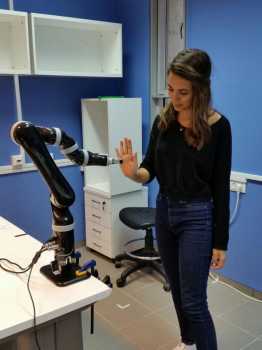24 Oct Personalizing Human-Robot Interactions Can Facilitate Rehabilitation
MedicalResearch.com Interview with:

Ben-Gurion University of the Negev student researcher Shir Kashi interacts with robotic arm as part of her research in personalizing human-robot interactions to develop an interactive movement protocol for rehabilitation.
Shelly Levy-Tzedek, PhD
Head of the Cognition, Aging and Rehabilitation Lab
Faculty of Health Sciences, Dept. of Physical Therapy
& The Zlotowski Center for Neuroscience
The Ben Gurion University
MedicalResearch.com: What is the background for this study? What are the main findings?
Response: Following brain injury, patients who need to practice their physical therapy exercises at home. Many don’t practice enough or at all at home, and so we are designing robot companions to encourage them to practice and to track their progress. This study is a first step towards this goal. Here, we studied how people played a leader-follower mirror game with a robotic arm, where a person and robot took turns following each other’s joint movements patterns. When the robotic arm was leading, it performed movements that were either sharp, like dribbling a ball, or smooth, like tracing a circle.
The study yielded three main conclusions. First, robotic movement primes the human movement. That is, the person tends to imitate the movements of the robot. This is a very important aspect to consider, for example, when designing a robotic nurse who assists a surgeon in the operating room. You wouldn’t want a robotic nurse to make sharp “robotic” movements that will affect the way the surgeon moves her hands during an operation.
Second, there was no clear-cut preference for leading or following the robot. Half the group preferred to lead the human-robot joint movement while half preferred to follow.
This finding highlights the importance of developing personalized human-robot interactions. Just as the field of medicine is moving towards customized medicine for each patient, the field of robotics needs to customize the pattern of interaction differently for each user.
Lastly, the study participants preferred smooth, familiar movements, which resemble human movements, over sharp (“robotic”) or unfamiliar movements when the robot was leading the interaction.
Thus, determining the elements in the interaction that make users more motivated to continue it is important in designing future robots that will interact with humans on a daily basis.
MedicalResearch.com: What should clinicians and patients take away from your report?
Response: People tend to imitate the robot’s movement . This makes it a very important design feature in all human-robot interactions – and this finding goes well beyond the field of “robotics in rehabilitation”, and includes robotics in industry, agriculture and more: it is important to consider what movements we would want the person interacting with the robot to make, and design the robot’s movements accordingly.
Every person has a different set of preferences when interacting with a robot, and so we should develop personalized human-robot interactions. Just as the field of medicine is moving towards customized medicine for each patient, the field of robotics needs to customize the pattern of interaction differently for each user.
MedicalResearch.com: What recommendations do you have for future research as a result of this study?
Response: The next step would be to test people’s preferences in specific contexts: different work environments, and different population groups. E.g., how does age affect people’s preferences when interacting with a robot? that is a question that we are in the process of addressing these days.
MedicalResearch.com: Is there anything else you would like to add?
Response: The initial research by Shir Kashi won a “best poster award” at the Human-Robot Interaction (HRI) Conference in Vienna this March. This study was a continuation of that research.
The study was funded by the Leir Foundation, Bronfman Foundation, Promobilia Foundation, The Israeli Science Foundation (grants # 535/16 and 2166/16). Additional funding was provided by the Helmsley Charitable Trust through the Agricultural, Biological and Cognitive Robotics Initiative and by the BGU Marcus Endowment Fund.
MedicalResearch.com: Thank you for your contribution to the MedicalResearch.com community.
Citation:
Shir Kashi, Shelly Levy-Tzedek. Smooth leader or sharp follower? Playing the Mirror Game with a Robot. Restorative Neurology and Neuroscience, 2017; 1 DOI: 10.3233/RNN-170756
Note: Content is Not intended as medical advice. Please consult your health care provider regarding your specific medical condition and questions.
[wysija_form id=”1″]
Last Updated on October 24, 2017 by Marie Benz MD FAAD
